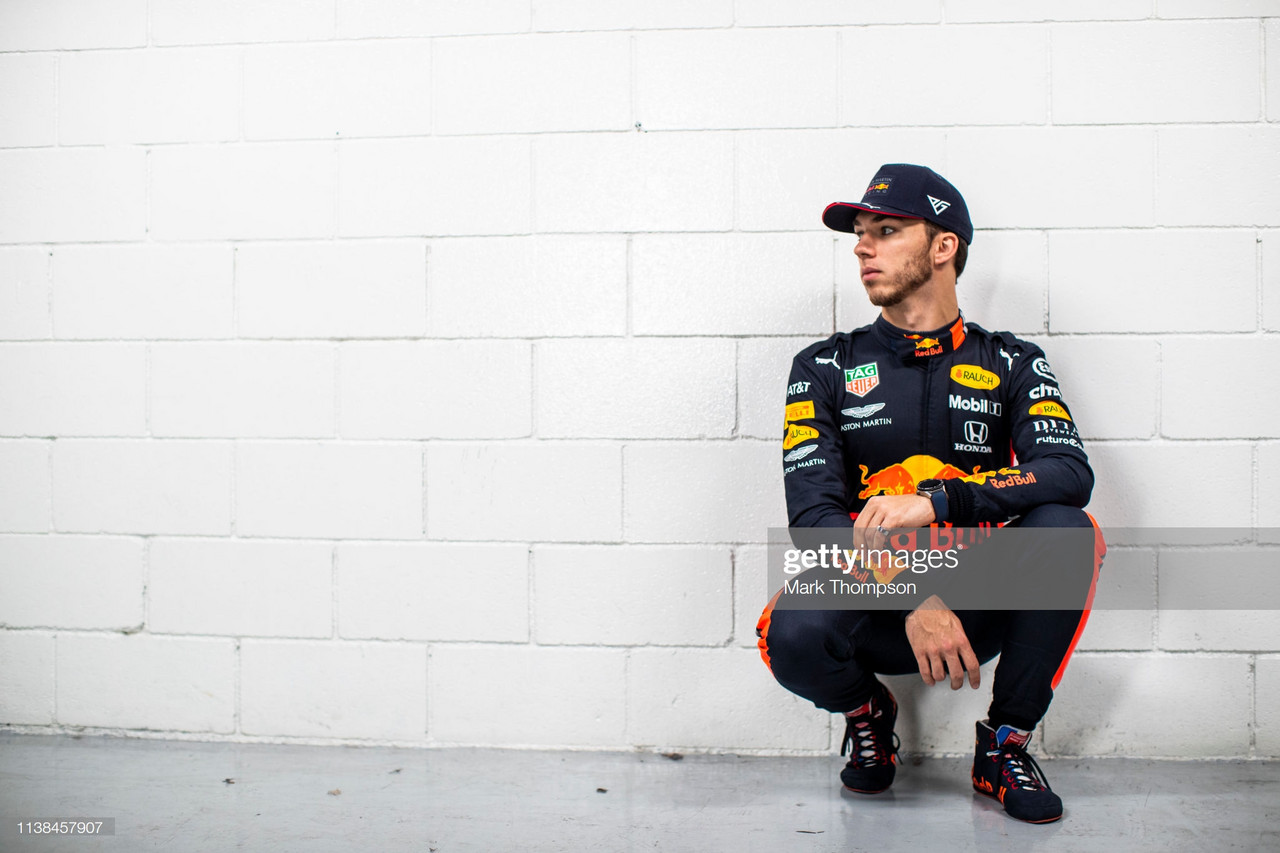The first series of the crime drama True Detective was, to be precise, an enthralling masterpiece. A marvel of storytelling and craftsmanship, the compelling eight-episode premiere season earned enough plaudits to be awarded an Emmy and was widely regarded as one of the best series of 2014.
If you, yourself, have had the pleasure of observing the exhilarating performances of Woody Harrelson and Matthew McConaughey as they investigate a list of unsolved crimes, you will be well aware of what is about to follow.
True Detective's sophomore season fell way short of the bar it set in the first series. A rushed production seemed obvious as the mysteries were far less compelling and the duo of Rachel McAdams and Colin Farrell failed to replicate the electrifying chemistry of their predecessors.
Why am I talking about True Detective, I hear you ask? It's because it arguably shares a strong similarity between that of Pierre Gasly's Formula One career.
If you haven't watched True Detective and you didn't understand any of that, you could also liken Gasly's past 18 months to that of a Karcher pressure washer.
Fresh out of the box, full of promise, it delivers exactly as it is advertised on Amazon or your local B&Q - your car is clean, patio immaculate.
After a year of delightful cleaning memories, you decide to purchase the accessories. The patio cleaner, the pipe & drain cleaning kit and even the dirt blaster extension, just for good measure.
Your investment fails to bear fruit. Within weeks, the plastic components inside the machine begin to corrode and before you know it, the hose can no longer withstand the intense water pressure and the pending death of your pressure washer has accelerated.
So when Gasly made his eye-catching breakthrough with Toro Rosso in the previous F1 season, it's incredibly puzzling to figure out how his time at Red Bull has curdled into such an unmitigated disaster.
Star in the making
Gasly's exuberant and aggressive driving style made an immediate impression in the opening rounds of the 2018 season. Fourth place in Bahrain provided Toro Rosso with just their seventh top-four finish in their 13-year history, but most importantly unearthed Gasly as a future star.
The Frenchman's amelioration was sustained as the season progressed, and inevitably Gasly was called upon to make the upgrade as Red Bull looked to fill the vacant seat left by the departing Daniel Ricciardo.
The impending transfer did little to derail Gasly's fruitful debut season and with the experience of the Japanese Super Formula under his belt, the 2016 GP2 Champion excelled at Suzuka to cap off what was a tremendous first campaign.
In recent years, we have found that drivers that had outshone their rivals in the lower feeder series' had struggled to make the transition into the elite tier of motor racing. Stoffel Vandoorne and Jolyon Palmer are two GP2 champions that fall into that category - two drivers that harness a raw pace, but unfortunately, don't possess a degree of adaptability to extract maximum performance from their car.
Adaptability is the key word here, and is an aspect that I believe is the key flaw in Gasly's current predicament.
Being a Number Two driver is difficult
The STR13, Scuderia Toro Rosso's 2018 challenger, was configured within the team's financial constraints and was ultimately designed for both Gasly and his team-mate Brendon Hartley - no hierarchy, no preferences, equal machinery.
Gasly's driving style, with his blend of late-braking and aggressive manoeuvring, suited the STR13 and enabled him to push his car beyond it's capabilities, thus seeing him beat team-mate Hartley in 13 of the 21 races.
Arriving at Red Bull, there is one man at the forefront of the manufacturers' operations - Max Verstappen. The team did little to disguise their Max fixation, and after all why should they not adhere to the talent and speed of a future world champion?
This immediately posed a problem for Gasly. In Formula One, results against your team-mates are analysed, magnified and scrutinised greater than ever. Stepping into a car that is built purposely for the driver on the other side of the garage is always going to leave you starting on the wrong foot.
Therefore it was acceptable that Gasly was eliminated in the second stage of qualifying in Melbourne. It was acceptable that he was unable to make ground on his lowly starting position as his best attempts to pass Daniil Kvyat proved futile.
What isn't acceptable, and might well prompt Red Bull to soon take action, is that after nine races Gasly hasn't progressed. Worryingly for Christian Horner, Gasly has regressed considerably, going from a sixth-place regular to languishing in amongst the midfield runners.
Over the course of the season, Verstappen has out-qualified Gasly by an average of 0.624 seconds a race. Of all the teams on the grid, unsurprisingly it's the largest gap between any team-mates and doesn't bode well for the struggling Frenchman.
The chasm in the pair's output was underlined at the Austrian Grand Prix, where Verstappen produced a sensational victory and lapped his team-mate in the progress.
Spielberg is a circuit with a limited technical requirement. To be lapped by a driver in the same machinery, on a track with just eight corners, exhibits a driver devoid of confidence.
For all the criticism that you could direct towards Gasly, there does seem to be an underlying issue that hasn't surfaced under the media spotlight. At his home Grand Prix, Gasly had looked set to produce a respectable result after an impressive opening stint, yet a change onto the hard compound tyre seen his afternoon stagnate, ironically thwarted by the man he replaced at Red Bull in the shape of Ricciardo.
Murmurs of discontent in regards to the 2019 Pirelli tyre compounds had been generated from one side of the Red Bull garage - the thinner tread delivers temperature issues that Gasly's been impuissant to rectify.
If Gasly is to salvage his Red Bull future, he must learn to adapt - and promptly.
Red Bull's reputation stands before them
We have all grown accustomed to Red Bull's ruthless approach with under-performing drivers.
One man touted as a potential replacement for Gasly has experienced the wrath of Helmut Mark first-hand. The vindictive nature of Kvyat's demotion in 2016 served to disintegrate the Russian's Formula One career, and it's only this year that Kvyat has been able to produce a miraculous revival and return to an F1 seat.
There is a looming sense that a similar situation might unfold should Gasly not deliver signs of improvement at both Silverstone and Hockenheim.
Horner claimed Gasly needs a mental "Ctrl+Alt+Del" in order to recover from his torrid start to the season, as the Red Bull chief executive expressed his full public support for his driver.
"I think we have got to somehow go 'Ctrl+Alt+Del' in his head and start again. He is a quick driver,
"The problem he has got is that Max is delivering every week, and that puts more pressure on him to perform, but we're sticking by him.
"We still believe in him and we'll give him all the support we can to try and nurture the talent we know he has."
Words of a similar ilk have been uttered before, and Gasly's predecessor Ricciardo will be well-aware of the frosty shoulder that leading members of the Red Bull team can give you.
Gasly needs time to rediscover the confidence, pace and talent that had forced him into the limelight. Whether he will be given that time, by a team renowned for their cut-throat management, remains to be seen.
Options from within the Red Bull driver programme are limited. It would be cruelly unfair to unsettle Kvyat's returning campaign and drivers on the market - Fernando Alonso, say for example - are extremely unlikely to participate mid-way through the current season.
But with Verstappen enrapturing the motorsport community with his exhilarating performances, Gasly's crisis could be exacerbated if the Dutch star maintains this level of performance - and that could ultimately put Gasly out of a job.









































